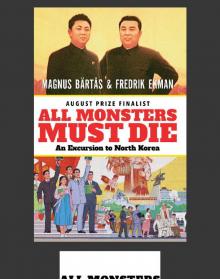- Home
- Magnus Bärtås
All Monsters Must Die Page 23
All Monsters Must Die Read online
Page 23
tourism, 12, 19, 21, 54
Truman, Harry S., 81, 83
The Truman Show, 37
Tsuburaya, Eiji, 193–95, 219
tunnels: under embassy buildings, 205; “infiltration,” 169; at Punggye-ri Nuclear Test Site/Hwasong concentration camp, 34, 40–41
U Kun-chol, 91–92
Ultraman (television series), 1, 193
The Underground Village (KAPF film), 145
Unification Church, 96–97
uniforms, 25, 111, 157; aesthetics of, 63, 124–25; Air Koryo, 10, 94; of airport workers, 54; Home Guard, 25, 99, 124; Mao suits as, 111, 126, 128, 140; military, 95, 165, 187; of road maintenance crews, 25, 52, 71; of tour guides/workers, 16, 59, 73–74, 77, 80; of traffic police, 16, 25, 126; of Youth Corps, 25, 52, 95, 165, 191
United Nations (UN): and Korean War, 82–83, 96, 171, 234–35; on North Korean conditions/human rights violations, 30, 243–44; Resolution 1718 of (2006), 34–35; sanctions by (2013), 241
Unsung Heroes (television series), 158–59
Victorious Fatherland Liberation War Museum, 16
Vinalon (“Juche fibre”) fabric, 125–26, 128, 157, 223
Vollertsen, Norbert, 218
Volvo cars, 25, 45, 152, 169
Warhol, Andy, 213
Washington Times, 96–97
Weber, Max, 144
website, official, of North Korea, 187
Wickman, Kurt, 77; and Pictures from North Korea, 78
Winnington, Alan, 17–18
Winslow, Frank, 18
women: clothing of, 13, 49, 111, 126, 127, 131, 222; Confucian attitude toward, 173; cosmetics for, 119, 124, 127, 128; marriage issues of, 62–63, 131; in postwar era, 228; Tenko as strong role model for, 216; traditional folk dress of, 7–8, 48, 126, 128, 142, 198, 203, 206, 228; uniforms of, 10, 16, 59, 73–74, 77, 80, 94, 124–25; wartime sex slavery of, 66–67; in work/prison camps, 41–43, 46
Workers’ Party of Korea, 14, 73, 85, 117, 240; Bureau 39 of, 162–63; conference of, 236; newspaper of, 73, 88, 139
Workers’ Party of North Korea. See entry above
World Cup: North Korea in, 235–36; South Korea in, 191
Yanggakdo Hotel, 19–20, 95, 128–36, 140, 167, 204, 236
Yi Jun, 122
Yoduk concentration camp (Kwan-li-so 15), 41–46
Yongbyon, nuclear energy facility in, 241
The Youth (Jeolmeun geudell), 174
MAGNUS BÄRTÅS is an artist and professor of fine arts at Konstfack, the University College of Arts, Crafts and Design in Stockholm. Among other works he has published an anthology about the borderland between literature and the visual arts.
FREDRIK EKMAN is a writer, librettist, and editor based in Stockholm. His musical works have toured across Europe.
MAGNUS BÄRTÅS and FREDRIK EKMAN have co-authored three books.
SASKIA VOGEL is a writer and a translator from Swedish. Her translations include The Summer of Kim Novak by Håkan Nesser and Who Cooked Adam Smith’s Dinner? by Katrine Marçal. She is also the Swedish series editor and translator for Readux Books. She lives in Berlin.
ABOUT THE PUBLISHER
House of Anansi Press was founded in 1967 with a mandate to publish Canadian-authored books, a mandate that continues to this day even as the list has branched out to include internationally acclaimed thinkers and writers. The press immediately gained attention for significant titles by notable writers such as Margaret Atwood, Michael Ondaatje, George Grant, and Northrop Frye. Since then, Anansi’s commitment to finding, publishing and promoting challenging, excellent writing has won it tremendous acclaim and solid staying power. Today Anansi is Canada’s pre-eminent independent press, and home to nationally and internationally bestselling and acclaimed authors such as Gil Adamson, Margaret Atwood, Ken Babstock, Peter Behrens, Rawi Hage, Misha Glenny, Jim Harrison, A. L. Kennedy, Pasha Malla, Lisa Moore, A. F. Moritz, Eric Siblin, Karen Solie, and Ronald Wright. Anansi is also proud to publish the award-winning nonfiction series The CBC Massey Lectures. In 2007, 2009, 2010, and 2011 Anansi was honoured by the Canadian Booksellers Association as “Publisher of the Year.”

 All Monsters Must Die
All Monsters Must Die